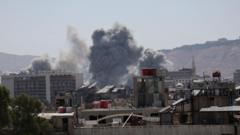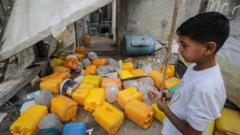Initially, around 90 truckloads of humanitarian assistance have arrived, amidst continuing debates over delivery mechanisms and ongoing military tensions.
Aid Begins to Flow into Gaza After Extended Israeli Blockade

Aid Begins to Flow into Gaza After Extended Israeli Blockade
Relief supplies finally reach the besieged territory, but stakeholders emphasize the need for increased aid volume.
Aid Deliveries Begin to Reach Gazans After Days of Delays
The U.N. reported that nearly 90 truckloads of humanitarian supplies have begun entering Gaza, marking a significant change after a crippling two-month blockade enforced by Israel. This delivery represents the first noteworthy influx of vital goods following an extended period of severe humanitarian crisis exacerbated by ongoing military operations.
Reports from both the U.N. humanitarian affairs office and Israeli military confirm the arrival of these supplies at various sites across Gaza after numerous days of delays. However, aid officials warn that this volume is merely a fraction of what the population desperately needs. The World Food Program highlighted the dire situation on social media, urging that the flow of aid trucks must increase to meet the growing demands of the populace.
The profound humanitarian crisis was largely fueled by Israel's recent prohibition on food and fuel imports as part of broader military efforts to pressure the Palestinian militant group Hamas. This ban has led to rampant food shortages within the territory, which has suffered devastation due to ongoing conflict. Israeli officials justified the blockade by claiming that Hamas has misappropriated aid supplies for its own gains — a stance that has faced skepticism from numerous international aid organizations.
Israel had insisted on the approval of a new aid distribution system that would allow the U.N. to operate only within Israeli-controlled areas. However, U.N. representatives and other nonprofits objected to the conditions, asserting that it would undermine their ability to provide aid effectively. Increased international pressure led to a compromise over the weekend, allowing the U.N. to resume food distribution under previous terms, though extended negotiations further delayed the actual deliveries.
The U.N.'s Office for the Coordination of Humanitarian Affairs (OCHA) reported that Israel mandated aid trucks to navigate a fraught route through Gaza, raising concerns about potential looting amidst the chaos. Despite ongoing discussions, a spokesperson from Israel’s military agency coordinating the aid response, known as COGAT, did not provide further comments on the situation.
In a recent televised address, Israeli Prime Minister Benjamin Netanyahu reiterated that escalation of military actions would continue unless Hamas complied with Israel's ceasefire requirements. He outlined a plan to establish designated evacuation areas in southern Gaza, where aid could safely be administered while ensuring Hamas's eradication from the area's future governance.
This situation remains fluid, and stakeholders continue to call for swift and ample humanitarian support to alleviate the suffering of those in Gaza amidst the persistent conflicts.
The U.N. reported that nearly 90 truckloads of humanitarian supplies have begun entering Gaza, marking a significant change after a crippling two-month blockade enforced by Israel. This delivery represents the first noteworthy influx of vital goods following an extended period of severe humanitarian crisis exacerbated by ongoing military operations.
Reports from both the U.N. humanitarian affairs office and Israeli military confirm the arrival of these supplies at various sites across Gaza after numerous days of delays. However, aid officials warn that this volume is merely a fraction of what the population desperately needs. The World Food Program highlighted the dire situation on social media, urging that the flow of aid trucks must increase to meet the growing demands of the populace.
The profound humanitarian crisis was largely fueled by Israel's recent prohibition on food and fuel imports as part of broader military efforts to pressure the Palestinian militant group Hamas. This ban has led to rampant food shortages within the territory, which has suffered devastation due to ongoing conflict. Israeli officials justified the blockade by claiming that Hamas has misappropriated aid supplies for its own gains — a stance that has faced skepticism from numerous international aid organizations.
Israel had insisted on the approval of a new aid distribution system that would allow the U.N. to operate only within Israeli-controlled areas. However, U.N. representatives and other nonprofits objected to the conditions, asserting that it would undermine their ability to provide aid effectively. Increased international pressure led to a compromise over the weekend, allowing the U.N. to resume food distribution under previous terms, though extended negotiations further delayed the actual deliveries.
The U.N.'s Office for the Coordination of Humanitarian Affairs (OCHA) reported that Israel mandated aid trucks to navigate a fraught route through Gaza, raising concerns about potential looting amidst the chaos. Despite ongoing discussions, a spokesperson from Israel’s military agency coordinating the aid response, known as COGAT, did not provide further comments on the situation.
In a recent televised address, Israeli Prime Minister Benjamin Netanyahu reiterated that escalation of military actions would continue unless Hamas complied with Israel's ceasefire requirements. He outlined a plan to establish designated evacuation areas in southern Gaza, where aid could safely be administered while ensuring Hamas's eradication from the area's future governance.
This situation remains fluid, and stakeholders continue to call for swift and ample humanitarian support to alleviate the suffering of those in Gaza amidst the persistent conflicts.




















